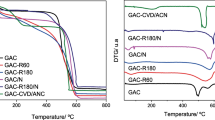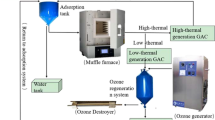Abstract
The main purpose of this study was to investigate the catalytic ozonation process with GAC–MgO in removal of benzene in air streams. The flow diagram of the experimental bench-scale setup included a glass column (internal diameter = 3 cm) packed for 10 cm with granular activated carbon coated with magnesium oxide. Different initial concentrations of benzene (80, 200 and 400 ppm) were used to evaluate the removal efficiency. The synthesized granular activated carbon coated by magnesium oxide was a microporous adsorbent with the BET specific surface area of 1028 m2/g. Hydroxyl, methylene, methyl, carboxylic groups and aromatic C=C bonds were some of the several functional groups identified on the its surface. In the catalytic ozonation process, the breakthrough time for the inlet concentration of 200 ppm increased from 36 h for granular activated carbon to 53 h for granular activated carbon ozonation. In other words, the concomitant use of activated carbon and ozone enhanced (from 36 h to 53 h) the removal efficiency of the system by 17 h in comparison with activated carbon alone. In the ozonation process for the bed, the benzene breakthrough time of the bed, for the inlet concentration of 200 ppm, increased from 44 h in the granular activated carbon coated by magnesium oxide system to 78 h in the granular activated carbon coated by magnesium oxide and ozonation. Eventually, the results showed the ozonation process in combination with the granular activated carbon coated by magnesium oxide catalyst.





Similar content being viewed by others
References
Adio SO, Mohammad ARI, Baiga N, Abdulrahman AAA, Saleh TA (2019) Poly (amidoxime) modified magnetic activated carbon for chromium and thallium adsorption: statistical analysis and regeneration. Process Saf Environ Prot 121:254–262
Bandosz TJ (2008) Removal of inorganic gases and VOCs on activated carbons. Adsorption by carbons. Elsevier, Amsterdam, pp 533–564
Biglari H, RodríguezíCouto S, Omidi Khaniabadi Y, Nourmoradi H, Khoshgoftar M, Amrane A, Vosoughi M, Esmaeili S, Heydari R, Mohammadi MJ, Rashidi R (2018) Cationic surfactant-modified clay as an adsorbent for the removal of synthetic dyes from aqueous solutions. Int J Chem Reactor Eng 16(5):1–14
Cervantes-Uc JM, Cauich-Rodríguez JV, Vázquez-Torres H, Garfias-Mesías LF, Paul DR (2007) Thermal degradation of commercially available organoclays studied by TGA–FTIR. Thermochim Acta 457:92–102
Chao CYH, Kwong C, Hui K (2007) Potential use of a combined ozone and zeolite system for gaseous toluene elimination. J Hazard Mater 143:118–127
Cooper CD, Alley FC (2002) Air pollution control: a design approach. Waveland Press, Long Grove
DiNardi SR (2003) The occupational environment: its evaluation, control, and management. AIHA Press (American Industrial Hygiene Association), Fairfax
Eaton AD, Clesceri LS, Rice EW (2005) Standard methods for the examination of water and wastewater (PAHA). American Water Works Association, Washington DC
Einaga H, Futamura S (2004) Catalytic oxidation of benzene with ozone over alumina-supported manganese oxides. J Catal 227:304–312
Gaur V, Sharma A, Verma N (2005) Catalytic oxidation of toluene and m-xylene by activated carbon fiber impregnated with transition metals. Carbon 43:3041–3053
Godish T (2016) Indoor environmental quality. CRC Press, Boca Raton
Gupa VK, Agarwal S, Saleh TA (2011) Chromium removal by combining the magnetic properties of iron oxide with adsorption properties of carbon nanotubes. Water Res 45(6):2207–2212
Huang S, Zhang C, Hong H (2009) In situ adsorption-catalysis system for the removal of o-xylene over an activated carbon supported Pd catalyst. Journal of Environmental Sciences 21:985–990
Kamarehie B, Jafari A, Ghaderpoori M, Karami MA, Mousavi K, Ghaderpoury A (2018a) Catalytic ozonation process using PAC/γ-Fe2O3 to Alizarin Red S degradation from aqueous solutions: a batch study. Chem Eng Commun. https://doi.org/10.1080/00986445.2018.1537266
Kamarehie B, Tizabi SMS, Heydari R, Jafari A, Ghaderpoori M, Karami MA, Ghaderpoury A (2018b) Data on the bisphenol A adsorption from aqueous solutions on PAC and MgO~PAC crystals. Data Brief 21:746–752
Kamarehie B, Jafari A, Ghaderpoori M, Karami MA, Mousavi K, Ghaderpoury A (2018c) Data on the alizarin red S adsorption from aqueous solutions on PAC, treated PAC, and PAC/γ≈Fe2O3. Data Brief 20:903–908
Khan FI, Ghoshal AK (2000) Removal of volatile organic compounds from polluted air. J Loss Prev Process Ind 13:527–545
Kwong C, Chao CY, Hui K, Wan M (2008) Removal of VOCs from indoor environment by ozonation over different porous materials. Atmos Environ 42:2300–2311
Lee Y-W, Park J-W, Choung J-H, Choi D-K (2002) Adsorption characteristics of SO2 on activated carbon prepared from coconut shell with potassium hydroxide activation. Environ Sci Technol 36:1086–1092
Liu P, Long C, Li Q, Qian H, Li A, Zhang Q (2009) Adsorption of trichloroethylene and benzene vapors onto hypercrosslinked polymeric resin. J Hazard Mater 166:46–51
Liu H, Wang X, Zhai G, Zhang J, Zhang C, Bao N, Cheng C (2012) Preparation of activated carbon from lotus stalks with the mixture of phosphoric acid and pentaerythritol impregnation and its application for Ni (II) sorption. Chem Eng J 209:155–162
Maldhure AV, Ekhe J (2011) Preparation and characterizations of microwave assisted activated carbons from industrial waste lignin for Cu (II) sorption. Chem Eng J 168:1103–1111
Massoudinejad M, Rasoulzadeh H, Ghaderpoori M (2019) Magnetic chitosan nanocomposite: fabrication, properties, and optimization for adsorptive removal of crystal violet from aqueous solutions. Carbohyd Polym 206:844–853
Mohsenibandpei A, Ghaderpoori M, Hassani G, Bahrami H, Bahmani Z, Alinejad AA (2016) Water solution polishing of nitrate using potassium permanganate modified zeolite: parametric experiments, kinetics and equilibrium analysis. Glob Nest J 18:546–558
Moussavi G, Mahmoudi M (2009) Degradation and biodegradability improvement of the reactive red 198 azo dye using catalytic ozonation with MgO nanocrystals. Chem Eng J 152:1–7
Moussavi G, Yazdanbakhsh A, Heidarizad M (2009) The removal of formaldehyde from concentrated synthetic wastewater using O3/MgO/H2O2 process integrated with the biological treatment. J Hazard Mater 171:907–913
Moussavi G, Khavanin A, Alizadeh R (2010a) The integration of ozonation catalyzed with MgO nanocrystals and the biodegradation for the removal of phenol from saline wastewater. Appl Catal B 97:160–167
Moussavi G, Khavanin A, Mokarami H (2010b) Investigating the effect of gas flow rate, inlet ozone concentration and relative humidity on the efficacy of catalytic ozonation process in the removal of xylene from waste airstream. Iran Occup Health 7:65–70
Moussavi G, Rashidi R, Khavanin A (2013) The efficacy of GAC/MgO composite for destructive adsorption of benzene from waste air stream. Chem Eng J 228:741–747
Rashidi R, Yousefinejad S, Mokarami H (2018) Catalytic ozonation process using CuO/clinoptilolite zeolite for the removal of formaldehyde from the air stream. Int J Environ Sci Technol. https://doi.org/10.1007/s13762-018-2059-2
Richards R, Mulukutla RS, Mishakov I, Chesnokov V, Volodin A, Zaikovski V, Sun N, Klabunde KJ (2001) Nanocrystalline ultra high surface area magnesium oxide as a selective base catalyst. Scr Mater 44:1663–1666
Saleh TA (2015a) Nanocomposite of carbon nanotubes/silica nanoparticles and their use for adsorption of Pb(II): from surface properties to sorption mechanism. Desalin Water Treat 57(23):10730–10744
Saleh TA (2015b) Isotherm, kinetic, and thermodynamic studies on Hg(II) adsorption from aqueous solution by silica- multiwall carbon nanotubes. Environ Sci Pollut Res 22:16721–16731
Saleh TA, Naeemullah, Tuzen M, Sari A (2017a) Polyethylenimine modified activated carbon as novel magnetic adsorbent for the removal of uranium from aqueous solution. Chem Eng Res Des 117:218–227
Saleh TA, Tuzen M, Sari A (2017b) Magnetic activated carbon loaded with tungsten oxide nanoparticles for aluminum removal from waters. Journal of Environmental Chemical Engineering 5(3):2853–2860
Saleh TA, Tuzen M, Ahmet Sari (2018a) Polyamide magnetic palygorskite for the simultaneous removal of Hg(II) and methyl mercury; with factorial design analysis. J Environ Manage 211:323–333
Saleh TA, Adio SO, Asif M, Dafalla H (2018b) Statistical analysis of phenols adsorption on diethylenetriamine-modified activated carbon. J Clean Prod 182:960–968
Shepherd A (2001) Activated carbon adsorption for treatment of VOC emissions. 13th annual EnviroExpo, Boston, Massachusetts, May 2001, p 4
Tang YB, Liu Q, Chen FY (2012) Preparation and characterization of activated carbon from waste ramulus mori. Chem Eng J 203:19–24
Thrower PA (2003) Chemistry & physics of carbon. CRC Press, New York
Tuzen M, Sari A, Saleh TA (2018) Response surface optimization, kinetic and thermodynamic studies for effective removal of rhodamine B by magnetic AC/CeO2 nanocomposite. J Environ Manage 206:170–177
Wang JH, Ray MB (2000) Application of ultraviolet photooxidation to remove organic pollutants in the gas phase. Sep Purif Technol 19:11–20
Water Environment Federation, American Public Health Association (2005) Standard methods for the examination of water and wastewater. American Public Health Association (APHA), Washington, DC
Yazdanbakhsh A, Hashempour Y, Ghaderpouri M (2018) Performance of granular activated carbon/nanoscale zero-valent iron for removal of humic substances from aqueous solution based on experimental design and response surface modeling. Glob Nest J 20:57–68
Zeydouni G, Kianizadeh M, Khaniabadi YO, Nourmoradi H, Esmaeili S, Mohammadi MJ, Rashidi R (2018) Eriochrme black-T removal from aqueous environment by surfactant modified clay: equilibrium, kinetic, isotherm, and thermodynamic studies. Toxin Rev. https://doi.org/10.1080/15569543.2018.1455214
Acknowledgements
We appreciate the Lorestan University of Medical Sciences and Tarbiat Modares University for providing financial and instrumental support for the laboratory work.
Author information
Authors and Affiliations
Corresponding author
Additional information
Editorial responsibility: M. Abbaspour.
Rights and permissions
About this article
Cite this article
Rashidi, R., Moussavi, G., Khavanin, A. et al. The efficacy of the ozonation process in the presence of activated carbon impregnated with magnesium oxide in the removal of benzene from the air stream. Int. J. Environ. Sci. Technol. 16, 8023–8030 (2019). https://doi.org/10.1007/s13762-019-02239-0
Received:
Revised:
Accepted:
Published:
Issue Date:
DOI: https://doi.org/10.1007/s13762-019-02239-0




